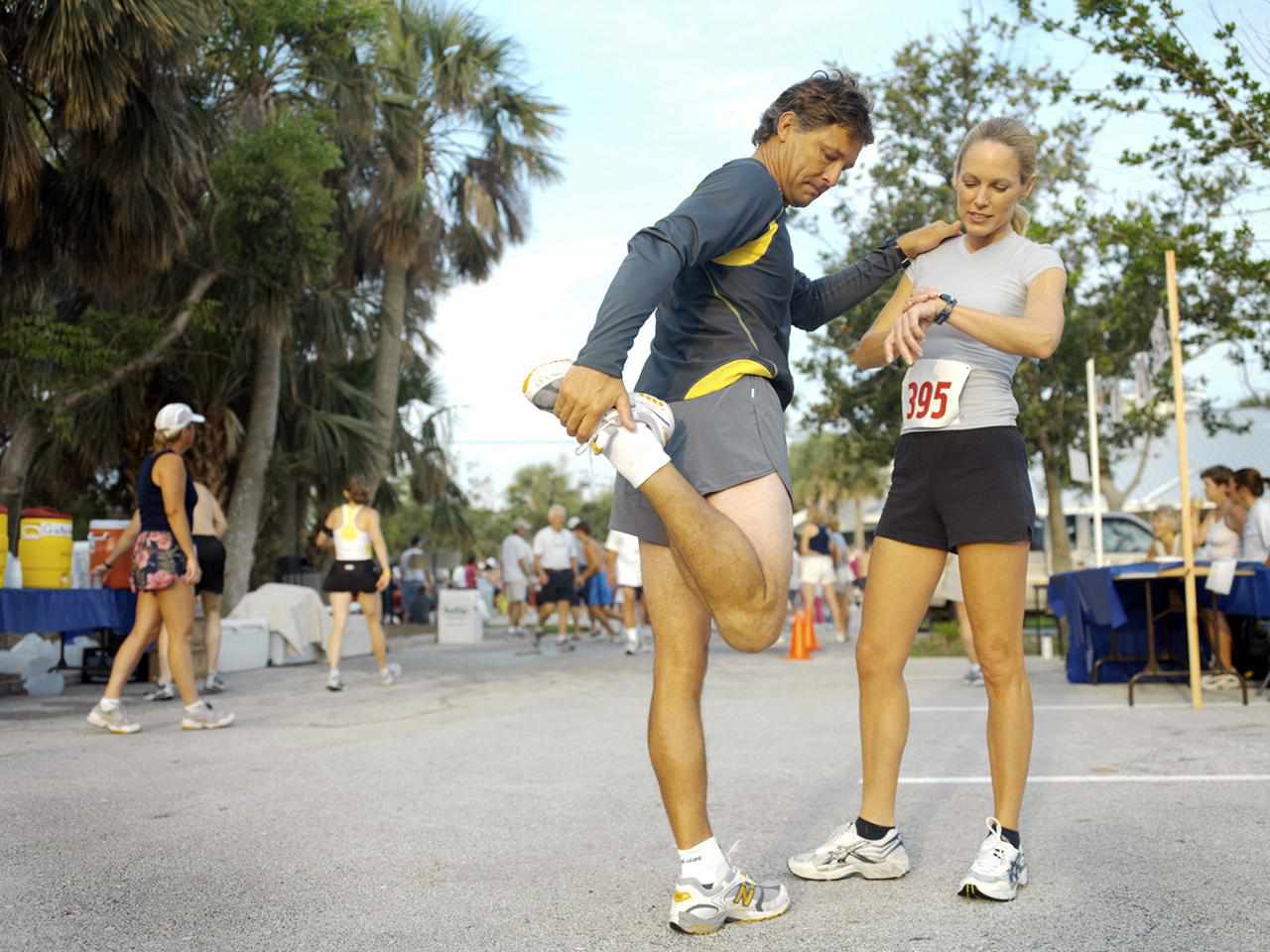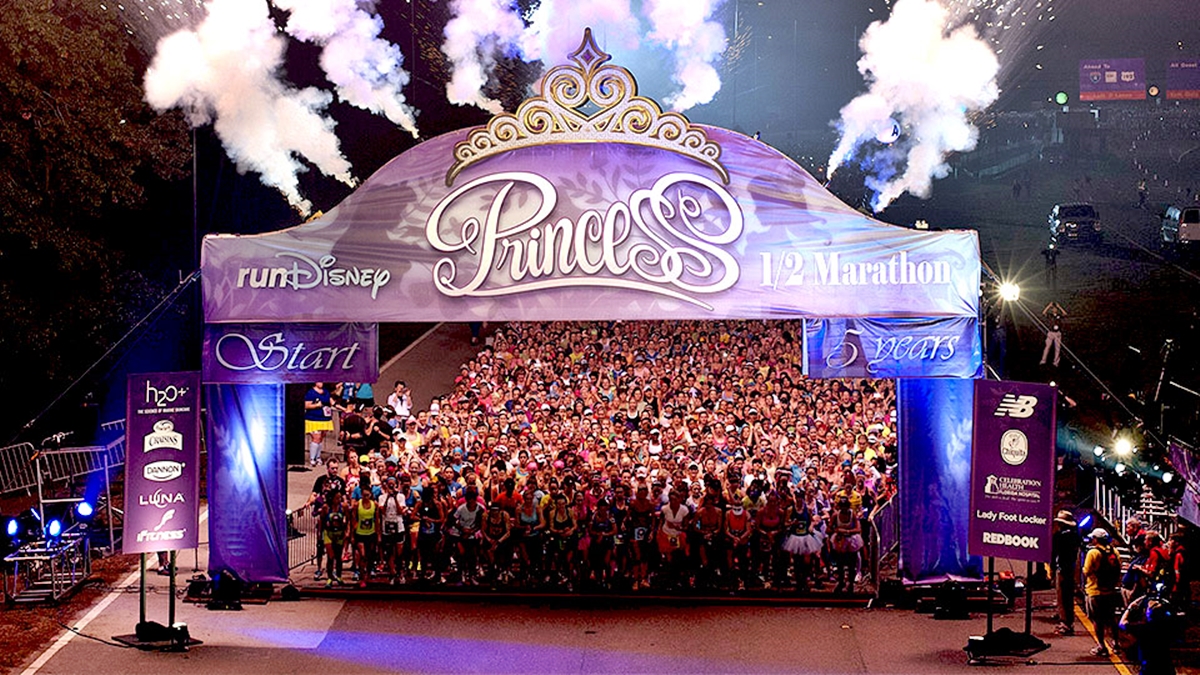Home>Misc>Featured>How To Train For A Half Marathon In One Month


Featured
How To Train For A Half Marathon In One Month
Modified: January 22, 2024
Discover the ultimate training plan to conquer a half marathon in just one month! Get featured and achieve your running goals with our expert tips and strategies.
Introduction
Welcome to the world of half marathon training! Training for a half marathon is an exciting and rewarding journey that requires dedication, commitment, and a well-planned training schedule. While most training programs recommend a minimum of 12 weeks to prepare for a half marathon, sometimes circumstances may arise where you find yourself with only one month to train. Though it may seem daunting, with the right approach and mindset, it is possible to successfully train for a half marathon in just one month.
In this article, we will provide you with a comprehensive guide on how to train for a half marathon in one month. We will walk you through the essential steps and strategies to maximize your training and improve your performance on race day. While this condensed training period may not allow for as much physical adaptation as a longer training plan, it still offers an opportunity to build endurance, increase your fitness levels, and cross that finish line with a sense of accomplishment.
Before we dive into the training details, it’s important to note that training for a half marathon in one month requires a baseline level of fitness. If you are new to running or have been inactive for an extended period, it’s advisable to consult with a healthcare professional before embarking on a training program.
Step 1: Set Clear Goals
Setting clear and realistic goals is crucial when training for a half marathon, especially within a limited time frame. Take some time to reflect on what you want to achieve from this training and what your target finish time is. Keep in mind that your goals should be specific, measurable, achievable, relevant, and time-bound.
For example, a specific goal for your half marathon training could be to complete the race within a certain time frame, such as finishing in under 2 hours. A measurable goal could involve tracking your training progress through mileage and pace improvements. An achievable goal can be based on your current fitness level and the amount of time you have available for training. Ensure that your goals are relevant to your abilities and aligned with your overall objectives.
Setting clear goals not only helps keep you motivated but also provides you with a benchmark to track your progress throughout your training. It enables you to focus your efforts and make adjustments as needed to ensure you are on track to meet your targets.
When setting your goals, remember to consider both outcome goals and process goals. Outcome goals are the ultimate result you want to achieve, such as finishing the half marathon. Process goals, on the other hand, are the daily or weekly actions you need to take to reach your desired outcome. They can include things like following your training schedule, completing speed workouts, or incorporating strength training exercises into your routine.
By setting both outcome and process goals, you create a roadmap that helps you stay motivated and disciplined throughout your training. Remember, it’s crucial to be realistic and adjust your goals if needed. Training in a condensed timeframe requires balance and adaptability to ensure you can maintain a steady and sustainable pace.
Step 2: Create a Training Schedule
Creating a training schedule is essential when preparing for a half marathon in one month. A well-structured schedule not only helps you stay organized but also ensures that you are gradually increasing your mileage and intensity to avoid overtraining or injury.
Start by determining how many days per week you can commit to running and training. Aim for a minimum of three to four days of running, allowing for adequate rest and recovery days in between. Next, consider your current fitness level and the amount of time you have available each day for training.
When building your training schedule, it’s important to include a mix of different types of runs, including long runs, tempo runs, speed work, and recovery runs. Long runs are the cornerstone of half marathon training as they help build endurance. Start with a comfortable distance and gradually increase it each week. For example, if you can comfortably run 5 miles at the start of your training, aim to increase your long run distance to 7 miles, then 9 miles, and so on.
Tempo runs involve running at a sustained, challenging pace. These runs help improve your lactate threshold and teach your body to maintain a faster pace for a longer period. Incorporate one or two tempo runs per week, gradually increasing the duration or speed of these workouts.
Speed work, such as interval training or hill repeats, helps improve your speed and running economy. Consider incorporating one speed workout per week, alternating between shorter, faster intervals and longer, slower intervals.
In addition to running workouts, don’t forget to include strength training and cross-training in your schedule. Strength training exercises, such as squats, lunges, and core exercises, help improve your overall strength and stability, reducing the risk of injury. Cross-training activities like cycling, swimming, or yoga can provide additional cardiovascular fitness and allow for active recovery on rest days.
As you create your training schedule, be sure to listen to your body and adjust your plan if needed. It’s normal to feel tired or sore during intense training periods, but it’s crucial to differentiate between normal fatigue and potential signs of overtraining. Rest and recovery days are just as important as the training days, so make sure to include them in your schedule.
By following a well-designed training schedule, you will be able to maximize your training time and gradually build up your fitness and endurance for the half marathon.
Step 3: Focus on Building Endurance
Building endurance is a key aspect of training for a half marathon, and it becomes especially important when you have limited time for preparation. Endurance is your ability to sustain a certain level of effort over an extended period, and it plays a crucial role in helping you complete the race strong.
To build endurance, prioritize your long runs. These runs should gradually increase in distance each week, allowing your body to adapt to the demands of running longer distances. Start with a comfortable distance and progressively add 10% to 15% to your long run every week.
During your long runs, focus on maintaining a conversational pace. This means running at a pace where you can comfortably hold a conversation without feeling breathless. It’s important to pace yourself during these runs, as going too fast can lead to burnout or injuries.
In addition to long runs, incorporate regular easy runs into your training schedule. These runs should be at a comfortable pace where you can easily hold a conversation. Easy runs help build your aerobic base and improve your overall endurance without placing too much stress on your body.
Another effective way to build endurance is by doing tempo runs. Tempo runs involve running at a pace that is comfortably hard but still sustainable for a significant duration. This type of workout helps increase your lactate threshold, allowing you to run faster for longer periods. Start with shorter tempo segments and gradually increase the duration or intensity as your training progresses.
It’s important to note that building endurance takes time and consistency. Even though you have a limited training period, be patient and trust the process. Gradually increasing your mileage and incorporating these key workouts will help boost your endurance levels and prepare you for the demands of the half marathon.
Remember to balance your training with proper rest and recovery. Overtraining can lead to fatigue and injury, so listen to your body and allow for adequate time to rest and recover.
By focusing on building endurance through long runs, easy runs, and tempo runs, you will improve your stamina and be better equipped to handle the distance of a half marathon.
Step 4: Incorporate Speed Workouts
Incorporating speed workouts into your training regimen can significantly improve your running performance and help you achieve your goals in a shorter training period. Speed workouts focus on increasing your running speed, improving your aerobic capacity, and enhancing your body’s ability to withstand intense efforts.
One type of speed workout you can include is interval training. Interval training involves alternating between periods of high-intensity running and recovery. For example, you can run at a faster pace for a specific distance or time, followed by a recovery period of jogging or walking. Repeat this cycle for a designated number of intervals. The intensity and duration of your intervals can be adjusted based on your fitness level and goals.
Hill repeats are another effective form of speed workout. Find a suitable hill with a moderate incline and sprint up the hill at a high effort level. Focus on maintaining good form and driving your knees up as you ascend. Once you reach the top, jog or walk back down to recover. Repeat this process for a set number of hill repeats.
Fartlek, a Swedish term meaning “speed play,” is a versatile and enjoyable speed workout. During a fartlek workout, you can vary your pace throughout your run, incorporating faster efforts whenever you feel ready. For example, you can sprint to a certain landmark, then recover with an easy jog before picking up the pace again. Fartlek runs can be done on roads, trails, or even on a treadmill.
When incorporating speed workouts into your training, it’s important to warm up properly before each session. Begin with a few minutes of easy jogging, followed by dynamic stretches or exercises to activate your muscles. After your speed workout, cool down with a few minutes of easy jogging and static stretches to help prevent muscle tightness and aid in recovery.
As you increase your speed and intensity during these workouts, remember to listen to your body and avoid overexertion. Start with shorter intervals or fewer hill repeats, and gradually increase the intensity and duration over time. The goal is to challenge yourself without risking injury or burnout.
It’s also important to note that speed workouts should be balanced with other types of runs, such as long runs and easy runs, to prevent overtraining and allow for proper recovery. Remember that rest and recovery are just as important as the training itself.
By incorporating speed workouts into your training plan, you will improve your running economy, increase your speed, and enhance your overall performance during the half marathon.
Step 5: Practice Proper Nutrition and Hydration
Nutrition and hydration play a vital role in supporting your training and optimizing your performance during a half marathon. Proper fueling and hydration before, during, and after your runs are essential to keep your body energized and hydrated.
Before your runs, ensure that you have a balanced meal or snack that includes carbohydrates, protein, and healthy fats. Carbohydrates provide the primary source of energy for endurance activities, while protein aids in muscle repair and recovery. Examples of pre-run meals or snacks include a banana with nut butter, Greek yogurt with fruits, or a whole grain toast with avocado.
During long runs, it’s important to replenish your energy stores with carbohydrates. Consider bringing energy gels, sports drinks, or snacks that are easily digestible and provide a quick source of carbohydrates. Experiment with different options during your training runs to find what works best for you. Additionally, hydration is crucial during long runs to replace fluids lost through sweat. Carry a water bottle or plan your route with water fountains along the way.
After your runs, prioritize your recovery by consuming a combination of carbohydrates and protein within 30 to 60 minutes. This helps replenish glycogen stores and aids in muscle recovery. Examples of post-run snacks include a protein shake, a smoothie with fruits and Greek yogurt, or a turkey and avocado sandwich.
Aside from fueling properly, hydrating adequately is essential throughout your training. Aim to drink water consistently throughout the day to maintain proper hydration. In addition to water, consider incorporating electrolyte-rich drinks or sports drinks to replenish key minerals lost through sweat.
It’s also important to listen to your body’s hunger and thirst cues. Everyone’s nutritional needs are different, so pay attention to how your body responds to different foods and adjust your intake accordingly. Keep in mind that nutrition is a personal journey, and it may take some trial and error to find what works best for you.
Lastly, don’t forget to prioritize quality sleep and recovery. Proper rest allows your body to repair and adapt to the training stress, which ultimately improves your overall performance. Aim for at least 7-8 hours of quality sleep per night, and incorporate rest days into your training schedule.
By practicing proper nutrition and hydration, you will optimize your energy levels, support your performance, and enhance your recovery during your one-month half marathon training.
Step 6: Strengthen Your Body
Strengthening your body is a crucial component of half marathon training, as it helps improve your running efficiency and reduces the risk of injury. Incorporating strength training exercises into your routine can enhance your overall performance and make you a stronger, more resilient runner.
Focus on exercises that target the muscles utilized in running, such as your core, glutes, quads, hamstrings, and calves. Planks, bridges, squats, lunges, and calf raises are excellent exercises to incorporate into your strength training routine.
Bodyweight exercises can be sufficient, but as you progress, you may want to add resistance using dumbbells, resistance bands, or weight machines. Aim to perform strength training exercises at least twice a week, allowing for a day of rest in between sessions for muscle recovery.
In addition to strengthening the major muscle groups, don’t neglect your core. A strong core improves stability and posture, enhancing your running form and reducing the risk of injuries. Incorporate exercises such as planks, Russian twists, and bicycle crunches to target your core muscles.
Remember to focus on proper form and technique while performing strength training exercises. If you’re new to strength training or unsure about proper form, consider working with a qualified trainer who can guide you and help you develop a personalized strength training plan.
Aside from traditional strength training exercises, consider incorporating cross-training activities that complement your running. Activities like swimming, cycling, or yoga not only provide a break from the impact of running but also help improve your cardiovascular fitness, enhance flexibility, and prevent muscle imbalances.
It’s important to note that strength training should be balanced with your running schedule. Avoid performing intense strength training on the same day as long runs or speed workouts, as it can negatively impact your performance. Instead, space out your strength training sessions accordingly to allow for proper recovery.
By incorporating strength training into your training program, you will improve your running efficiency, reduce the risk of injuries, and become a stronger, more well-rounded runner.
Step 7: Don’t Forget about Rest and Recovery
Rest and recovery are often overlooked but are vital components of a successful half marathon training plan, especially when you have a limited time frame. Giving your body sufficient time to rest and recover allows for muscle repair and adaptation, reducing the risk of overuse injuries and improving overall performance.
When creating your training schedule, be sure to incorporate rest days. These are days specifically designated for rest and recovery, where you refrain from any intense physical activity. Rest days allow your body to repair and replenish energy stores, which helps prevent fatigue and burnout.
Additionally, consider incorporating active recovery into your training plan. Active recovery involves engaging in light activities such as walking, cycling, or stretching on the days between your more intense workouts. This helps promote blood flow to your muscles, aiding in recovery and reducing muscle soreness.
Quality sleep is also crucial for rest and recovery. Aim for 7 to 8 hours of uninterrupted sleep per night to support proper hormonal balance, muscle repair, and mental well-being. Establish a regular sleep schedule and create a sleep-friendly environment to ensure you’re getting the rest your body needs.
It’s important to listen to your body and recognize the signs of overtraining or fatigue. Pushing yourself too hard without adequate rest can lead to decreased performance, increased risk of injury, and mental burnout. If you experience persistent fatigue, muscle soreness, or a decline in motivation, it may be a sign that you need an extra day or two of rest.
In addition to rest days, incorporating recovery strategies such as stretching, foam rolling, and light massage can help alleviate muscle tension and improve flexibility. These techniques promote blood circulation, increase range of motion, and accelerate recovery from tough training sessions.
Lastly, don’t forget about proper nutrition and hydration as part of your rest and recovery routine. Consuming a balanced diet that includes nutrient-dense foods will support your body’s recovery process and optimize muscle repair. Hydration plays a significant role in recovery as well, so remember to drink enough water throughout the day to maintain proper hydration levels.
By prioritizing rest and recovery, you allow your body to adapt and respond positively to the demands of training. It’s not just about the miles you run but also the quality of your recovery that will make a difference in your performance on race day.
Step 8: Test Your Progress with a Practice Run
As you near the end of your one-month half marathon training, it’s essential to assess your progress and gauge your readiness for the race. One way to do this is by conducting a practice run, also known as a “dress rehearsal.”
A practice run allows you to simulate race conditions and test your physical and mental preparedness. It gives you an opportunity to assess your pacing, nutrition and hydration strategies, and identify any potential issues that may arise on race day.
Choose a route that closely resembles the race course in terms of terrain and elevation. This will help familiarize yourself with the conditions you’ll encounter on race day. Ideally, aim to complete the same distance as the half marathon or at least a significant portion of it.
Prior to the practice run, fuel your body adequately with a similar pre-run meal as you plan to have on race day. Dress in the same apparel and use the same running gear, including shoes, socks, and any accessories you intend to wear during the race. This will help you identify any discomfort or issues that may arise.
During the practice run, pay close attention to your pacing. Start at a comfortable pace and gradually increase your speed if you feel comfortable doing so. Practice maintaining a steady pace throughout the run, and take note of how you feel at different points in the distance.
Test your nutrition and hydration strategies during the practice run. Carry any energy gels, snacks, or sports drinks that you plan to use on race day. Determine when and how often you will consume them, and see how your body responds. Pay attention to any signs of fatigue or energy depletion and adjust your plan accordingly.
Use the practice run as an opportunity to fine-tune your mental strategies as well. Focus on staying positive and maintaining a strong mental attitude. Practice visualization techniques, imagine crossing the finish line, and remind yourself of your goals and motivations.
After the practice run, assess your performance and take note of any areas that need improvement. Reflect on your pacing, nutrition and hydration strategies, as well as your mental focus and mindset. Identify any weaknesses or adjustments that need to be made before race day.
Remember, the practice run is not meant to be a full-out race effort. It’s an opportunity to test your physical and mental readiness and make any necessary tweaks to your race plan. Use the information and insights gained from the practice run to refine your strategy for the actual half marathon.
By conducting a practice run, you’ll gain valuable experience, build confidence, and ensure that you are well-prepared and ready to tackle the challenge of the half marathon on race day.
Conclusion
Congratulations! You have reached the end of this comprehensive guide on how to train for a half marathon in just one month. While it may seem like a challenging task, with the right mindset, commitment, and proper planning, you can successfully prepare yourself for the race.
Throughout this training journey, you have learned the importance of setting clear goals, creating a well-structured training schedule, focusing on building endurance, incorporating speed workouts, practicing proper nutrition and hydration, strengthening your body, prioritizing rest and recovery, and testing your progress through a practice run.
Remember, the key to successful training is finding a balance between pushing your limits and listening to your body. Be adaptable and flexible in adjusting your training plan if needed. It’s normal to face obstacles and setbacks along the way, but with determination and persistence, you can overcome them.
On race day, trust in your training and believe in yourself. Stay calm, focus on the process, and enjoy the experience. Remember that completing a half marathon is a remarkable achievement regardless of your finishing time.
Lastly, always prioritize your health and safety. If at any point during your training you experience pain or discomfort, consult with a healthcare professional to address any concerns and ensure you’re taking the necessary steps to avoid injury.
Now, lace up your running shoes, rejoice in the progress you’ve made, and embrace the challenge of the half marathon. With your one-month training plan, determination, and a positive mindset, you are well-equipped to conquer the 13.1 miles that lie ahead.
Make sure to celebrate your accomplishments and continue to pursue your running goals beyond the half marathon. Whether it’s tackling a full marathon or exploring new distances, the lessons learned and the strength gained from training for a half marathon will stay with you throughout your running journey.
Good luck, and enjoy every step of your half marathon training and race!









